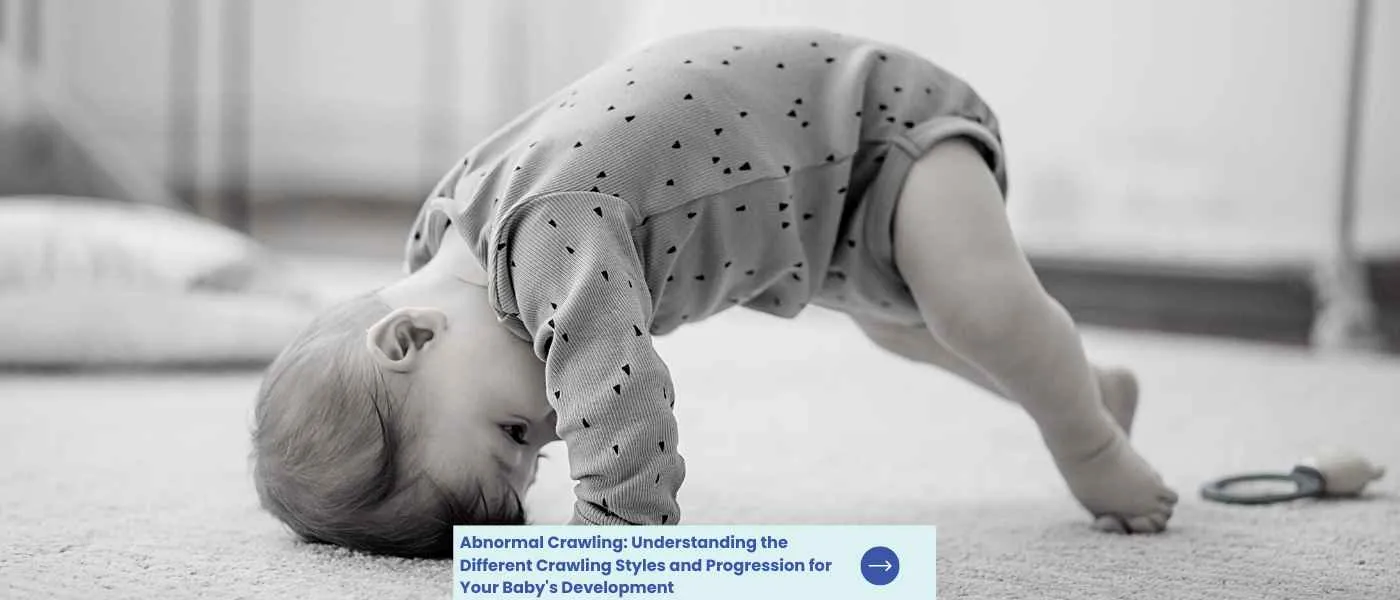As parents and caregivers, we eagerly await our baby’s first crawl as a sign of their growing independence and mobility. Crawling is an important milestone in a baby’s development that can occur in different styles and progression stages. Understanding these different styles and stages can help identify irregular crawling patterns and provide early intervention to support your baby’s overall development.
Key Takeaways on Abnormal Baby Crawling
- Crawling is an essential milestone in a baby’s development, offering many benefits for physical and cognitive development.
- Understanding the different baby crawling styles and progression stages can help identify irregular crawling patterns and provide early intervention to support your baby’s overall development.
- By creating a safe and supportive crawling environment, parents can encourage healthy crawling that helps strengthen the baby’s physical ability and other motor skills.
Benefits of Crawling for Baby’s Development
Crawling is one of the important developmental milestones in many babies. It is a new skill they learn before learning how to walk. As the baby learns, they go through physical and cognitive development. Crawling helps improve hand-eye coordination, spatial awareness, and brain development by providing stimulation for different parts of the brain. It also prepares the baby’s hip joints for standing and walking.
Watching your baby learn how to crawl, you will notice that they will learn to coordinate movements between their leg muscles and shoulder muscles and use their body equally.
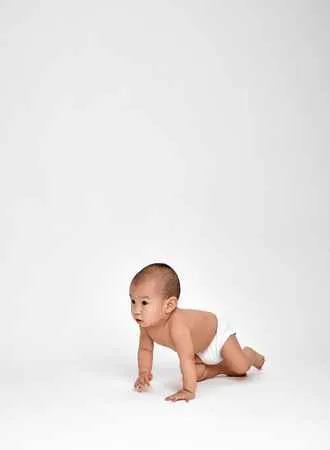
Common Concerns About Crawling Patterns
While most babies follow a similar crawling progression, there may be concerns about irregular crawling patterns. Some babies may skip crawling altogether and go straight to walking, while others may crawl in a unique style that raises concerns.
For example, some babies may crawl with one foot turned inward, which can be a sign of a hip problem. If you have any concerns about your crawling baby, it is important to speak with your healthcare provider or a developmental specialist.
Different Crawling Styles
There are different crawling styles that other babies may adopt during their crawling phase. These styles include:
- Belly Crawl — This style involves moving forward while lying on the tummy, pushing themselves forward using their arms and legs while keeping their head down.
- Commando Crawl or Commando Style Crawl — Also known as “army crawl” or “belly crawl with one knee down,” this style involves dragging their bodies forward while keeping their tummy on the ground and a knee down.
- Crawling on Hands and Feet — Also known as the “bear crawl,” this style involves crawling forward on their hands and feet, providing a stable base and is commonly used by babies who have mastered crawling on their belly.
- Crawling on Knees — In this style, babies move forward while on their knees, putting their hands on the floor and moving their knees back and forth, also called the classic crawl
- Crawling on Hands and Knees — This style involves moving forward while on the hands and knees, with babies using one arm on one side and the opposite leg on the opposite side, propelling themselves forward during floor time.
- Tripod Crawl — This style involves moving forward while on one hand and both knees, moving one hand forward while moving the opposite knee forward, alternating sides to move forward.
- Bottom Scooter — In this position, babies scoot around on their butts on the floor while using both upper body and arms to move forward.
- Crab crawl — In this less common crawl style, the baby pushes instead of pulls.As long as your baby is making progress in their overall development and there are no concerns about irregular crawling patterns, there is no need to worry about the specific style of crawling they use.
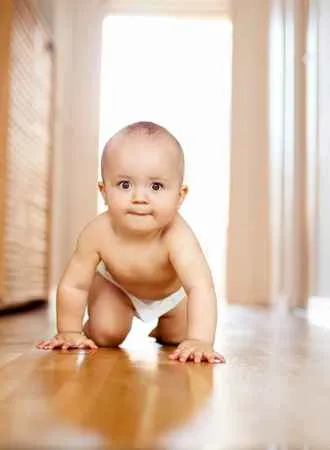
Crawling Progression
Crawling is a complex motor skill that involves the integration of several movements. Most babies switch styles as they progress through their crawling stage.
- Rocking Back and Forth: This stage involves rocking back and forth on the hands and knees without any forward movement.
- Pushing Backwards: In this stage, babies push themselves backward instead of forward, usually after learning to sit independently.
- Army or Commando Crawling: Crawling on the belly with one knee down and one foot up.
- Belly Crawling: Crawling forward while lying on the tummy, using arms and legs to propel themselves forward.
- Crawling on Hands and Feet: Crawling on hands and feet, providing a stable base once babies have mastered crawling on their belly.
- Crawling on Hands and Knees: Crawling on hands and knees, with babies using their hands to push themselves forward while moving their knees back and forth.
- Standing Up: Pulling themselves up to stand using furniture or other objects for support.
Creating a Safe and Supportive Crawling Environment
To encourage healthy crawling, parents can create a safe and supportive crawling environment for their baby. Some tips for creating a supportive environment for crawling include:
- Clearing the area: Remove any hazardous items or sharp corners that can harm your baby during crawling.
- Providing a soft surface: Use a soft mat or carpeted area for your baby to crawl on.
- Placing toys within reach: Place toys or objects just out of the baby’s reach to encourage them to move forward and explore.
- Being patient: Allow your baby to explore and move at their own pace, without rushing or forcing them to crawl before they are ready.

FAQs on Crawling Stages
When do babies begin crawling?
Babies can begin crawling at different ages, but the typical range is between six and ten months. Some babies may start crawling as early as six months, while others may not crawl until ten months or later.
It is important to remember that every child is different and will develop at their own pace. Some babies skip crawling altogether and move straight to walking.
Is it normal for babies to crawl in different styles?
Yes, it is normal for babies to crawl in different styles as they explore and develop their skills.
When should babies start crawling?
Babies can start crawling as early as six months or as late as ten months. However, it is essential to remember that all babies develop at their own pace, and some may skip the crawling phase altogether and go straight to walking.
What can I do to encourage my baby to crawl?
You can encourage your baby to crawl by placing toys or objects just out of reach to encourage them to move forward. You can also create a safe and supportive environment for crawling, such as a soft mat or carpeted area.

What if my baby skips crawling and goes straight to walking?
While crawling is an essential milestone in a baby’s development, not all babies crawl. Some babies may skip the crawling stage altogether and go straight to walking. This is not necessarily a cause for concern, as long as your baby is showing other signs of normal development.
Should I be concerned if my baby crawls in an unusual way?
Most babies adopt their unique style of crawling, and it’s not always a cause for concern. However, if you notice that your baby is crawling in an unusual or asymmetric way, such as dragging one leg or arm, it’s best to consult with your pediatrician.
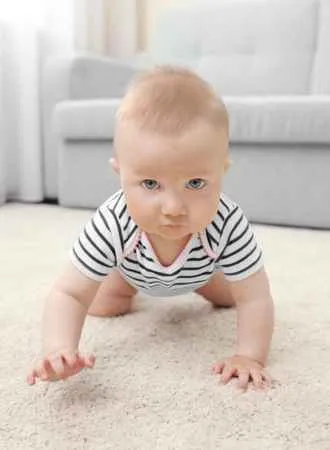
What can I do to help my baby if they seem to be struggling with crawling?
If your baby is struggling with crawling, you can try to encourage them by placing toys or objects just out of reach to encourage them to move forward. You can also create a safe and supportive environment for crawling, such as a soft mat or carpeted area.
Is it normal for babies to prefer one crawling style over another?
Yes, it’s normal for babies to prefer one crawling style over another, as each baby has their unique way of exploring and developing their skills.
Can babies learn to crawl at different ages?
Yes, babies can learn to crawl at different ages. While some babies may start crawling as early as six months, others may not start until ten months or later. It’s important to remember that all babies develop at their own pace, and there is a wide range of what is considered normal.
Does tummy time help babies learn how to crawl?
Tummy time is an essential exercise for babies that helps them develop crucial skills and prepare for crawling. During tummy time, babies are placed on their stomachs while awake and supervised, allowing them to build strength in their neck, back, and arms.
When a baby is born, their muscles and nervous system are not yet fully developed. By encouraging tummy time from an early age, parents and caregivers can help the baby build their core muscles, which are necessary for supporting the head and body. As the baby grows and gains strength, they can eventually push themselves up on their arms, lift their head and look around, and eventually crawl.
Tummy time also helps babies develop their visual and spatial skills. By looking around from their belly, babies can begin to understand depth perception and spatial awareness. As they push themselves up on their arms, they can begin to see the world from a different angle and develop their eye-hand coordination.
Another benefit of tummy time is that it helps babies avoid flat head syndrome. When babies spend too much time on their backs, they can develop a flat spot on the back of their head. By alternating between tummy time and other positions, parents and caregivers can help prevent this condition and promote healthy head shape.
As babies continue to practice tummy time and gain strength and confidence, they will eventually start to crawl. Crawling is an important milestone that allows babies to explore their surroundings, develop their muscles and coordination, and interact with the world in new ways. As your baby starts crawling, you will be surprised at how fast your baby moves.
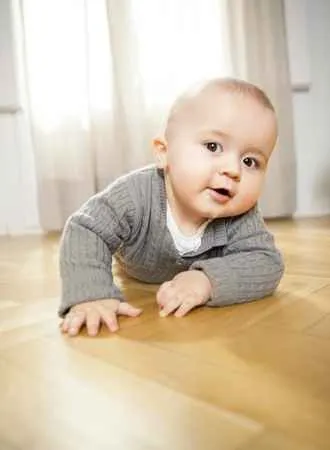
Can babies use baby walkers after learning to crawl?
It is not recommended to let your baby use a walker, regardless of your baby’s crawling skills. Walkers can delay their development of essential motor skills such as crawling, standing and walking. Moreover, baby walkers can be hazardous as they allow babies to move quickly and reach dangerous objects, resulting in falls and accidents that can cause severe injuries.
Walkers can also lead to developmental delays and issues such as shortened attention span, reduced exploration and learning opportunities, and decreased motivation to develop their muscles and coordination.

